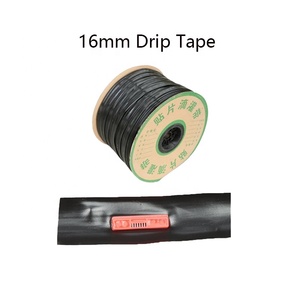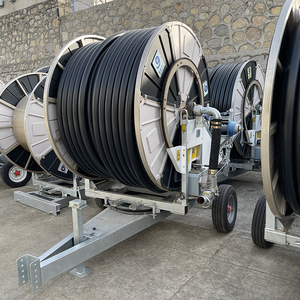(38166 products available)



































































































































































































































































A drip irrigation system is a type of localized irrigation system. It allows water to drip slowly to the plant's roots, either directly onto the soil or into the soil. This method of watering plants is very beneficial for conserving water and ensuring that plants receive the right amount of water they need to thrive. There are two main types of drip irrigation systems.
Surface drip irrigation system
A surface drip irrigation system is mainly used in flat areas where the ground is level. This system is placed on the surface of the ground. It can be used in greenhouses, gardens, and large farms. The pipes and emitters deliver water directly to the base of each plant. This minimizes water wastage and ensures that the plants get the water they need. The system is usually very affordable and easy to install. Farmers can move it around from one place to another quite easily. It also works with different types of crops.
Subsurface drip irrigation system
This system is installed below the surface of the soil. It is mainly used in areas where the land is sloping or on hilly terrain. The system delivers water directly to the plant roots underground. This reduces water evaporation. It also allows water to go deep into the soil, which is good for the roots. A subsurface drip irrigation system is less visible above the ground. This makes it less likely to be damaged. It can be used in many applications, such as big farms, orchards, and vineyards. Although it is costly and complicated to install, it is very efficient in the long run.
Emitter:
The emitter, or dripper, is the key component of a drip irrigation system. It regulates the release of water from the mainline to the plants. Emitters come in various flow rates, from 1 to 8 liters per hour, and can be pressure-compensating or non-pressure-compensating. Drip irrigation systems often use inline emitters, which are integrated into the drip tubing at regular intervals.
Drip Tubing:
Drip tubing is the mainline of the drip irrigation system. It is made of durable, UV-resistant plastic to withstand sunlight and harsh weather conditions. Drip tubing comes in various diameters, typically ranging from 1/4 inch to 1 inch. It can be laid above or below ground, depending on the installation requirements and the type of crops being irrigated.
Filters:
Filters remove dirt, debris, and other impurities from the water supply to prevent clogs in the emitters. Different types of filters are used in drip irrigation systems, including screen filters, disc filters, and sand media filters. The type of filter used depends on the water quality and the specific irrigation system requirements.
Fittings and connectors:
They include a variety of items used to join, bend, and branch out drip tubing. These components allow for flexibility in system design and ensure a tight, leak-free connection. Common fittings are barbed connectors, compression fittings, tees, elbows, and end caps.
Pressure regulator:
A pressure regulator is necessary if the water supply pressure is too high for the drip irrigation system. It lowers the incoming water pressure to the desired level, preventing damage to the emitters and other system components. Drip irrigation systems work best with a water pressure of 1 to 3 bars (15 to 45 psi).
Backflow preventer:
A backflow preventer is a critical component that stops the irrigation water from flowing back into the main water supply. It prevents contamination of the drinking water supply and is often a legal requirement in many areas.
The versatility of drip irrigation systems makes them a valuable solution in different scenarios for efficient and targeted watering of plants. This system is ideal for:
Row crops
Crops such as tomatoes, cucumbers, carrots, and beans benefit from a consistent water supply. The drip irrigation system delivers water directly to the root zone of these crops, thus minimizing evaporation, reducing weed growth, and allowing for precise water control.
Greenhouses
In a controlled environment like a greenhouse, a drip irrigation system ensures that plants such as peppers, herbs, and orchids receive the right amount of water without overwatering. This system is especially useful in optimizing water usage and maintaining humidity levels.
Fruit trees
Drip irrigation systems are well-suited for orchards with trees like apple, orange, and avocado. They supply water to deep roots and can be adjusted to meet the various needs of different tree species.
Landscaping and gardens
The system is perfect for residential landscaping, flower gardens, and vegetable gardens. It conserves water by irrigating plants in the specific areas where they are rooted and can be timed to water during the earliest or latest hours to minimize evaporation.
Desert and arid regions
Areas with limited water supply and high temperatures can leverage the efficiency of a drip irrigation system. This is applicable to drought-resistant plants such as cacti and succulents or in vegetable gardens producing in hot climates.
Hanging baskets and container gardens
For plants in hanging baskets and containers, a drip irrigation system provides consistent and efficient watering. This is important for maintaining proper moisture levels in individual containers.
Roof gardens and vertical gardens
The system is applicable in urban areas with limited space for traditional gardens. Drip irrigation systems deliver water directly to the roots of plants in vertical space-saving structures.
Sports fields and golf courses
The system is applicable in maintaining the turf and specific areas of the field. For example, in a baseball diamond, the irrigation system waters only the infield. In a golf course, it can target greens and tees, thus conserving water and providing healthy grass.
Wholesale buyers should consider these factors when selecting a drip irrigation system for retail.
Target Market
Identify the primary customers and their needs. Consider the customer's experience with irrigation systems, from residential users who want simple solutions to large farms needing complex systems. Select systems that serve each group's expertise and requirements.
Scalability and Modularity
Opt for systems that can be easily expanded or customized. Drip irrigation needs may increase over time or differ among users. Modular designs allow adding components without replacing the whole system. This flexibility lets customers scale their irrigation as needed.
Durability and Materials
Choose systems with durable materials that can withstand various environments. Look for components made from UV-resistant plastics or reinforced metals. Long-lasting materials reduce the need for replacements and give customers better value.
Technology and Automation
Consider systems with advanced features like soil moisture sensors and automated timers. These technologies optimize water use and reduce manual work. Drip irrigation systems with tech appeal to customers who want efficient and modern solutions.
Installation and Maintenance
Evaluate how easy it is to install and maintain the drip irrigation systems. Systems that are simple to set up will attract customers who do not have technical expertise. Clear manuals, few tools needed for installation, and accessible components for maintenance are vital.
Compatibility
Check if the drip irrigation systems work with other irrigation products. Systems that integrate well with pumps, filters, and water storage solutions give customers a complete solution. Compatibility simplifies product bundling and cross-selling opportunities.
Regulatory Compliance
Know the irrigation regulations and standards in the target market. Select drip irrigation systems that satisfy these rules to prevent legal issues. Compliance with local laws also boosts customer confidence in the product's safety and reliability.
Testing and Certification
Look for certified irrigation systems that have undergone third-party testing for performance and quality. Certification gives assurance about the product's reliability. It also makes the product more trustworthy in a competitive market.
Q1: How can one control the amount of water delivered by a drip irrigation system?
A1: The water flow can be controlled using drip emitters with different flow rates. Additionally, valves and timers can regulate the system to provide the desired amount of water.
Q2: What types of plants benefit most from drip irrigation?
A2: Drip irrigation is ideal for plants that require consistent amounts of water, such as vegetable gardens, fruit trees, and landscaping plants. It helps conserve water and promotes healthy growth.
Q3: How does one prevent clogs in a drip irrigation system?
A3: Clogs can be prevented by using a filter to remove debris from the water before it enters the system and installing pressure-regulating devices to maintain even pressure.
Q4: Can drip irrigation be used with different water sources?
A4: Drip irrigation can be used with various water sources, including municipal supplies, wells, and rainwater harvesting systems. It is a flexible and efficient method for watering plants.
Q5: Is drip irrigation suitable for all soil types?
A5: Drip irrigation can be used in all soil types. However, the system may need to be adjusted for different soils to ensure even water distribution and prevent overwatering or underwatering.
The web search volume for "drip irrigation system" has shown significant fluctuations over the past year, with an average monthly web search volume of 22,200. Despite a notable one-year increase of 49%, the keyword experienced a steep three-month decline of 45%. The year-long data reveals a seasonal pattern, with web search volumes peaking in the summer months, particularly in June 2024 with 49,500 web searches, and dipping to their lowest in the winter, around January 2024 with only 6,600 web searches.
This trend indicates a clear seasonal influence on the interest in drip irrigation systems, which are likely more in demand during the growing season when agricultural and gardening activities intensify. The peak months from May to July 2024, with web search volumes consistently above 40,000, align with the planting season in many regions, suggesting that farmers and gardeners are preparing for irrigation needs during this period. Conversely, the sharp decrease in web searches from October 2024 to January 2024, where the volume dropped from 14,800 to 6,600, corresponds with the off-season in many agricultural cycles.
The data suggests that while the overall interest in drip irrigation systems has grown over the past year, the demand is highly seasonal. This pattern could reflect broader trends in agricultural practices, where irrigation systems are planned and purchased well in advance of the planting season. Understanding these trends can help manufacturers and retailers in the home garden sector plan their production and marketing strategies more effectively.